Ante KRPAN, Tomislav PORŠINSKY and Marijan ŠUŠNJAR
Department of Forest Harvesting, Forestry Faculty of Zagreb University, CROATIA
Summary
Terrain conditions determine the ability of people and the mobility of vehicles to carry out forest works. In timber extraction from hilly-mountainous selection forests in Croatia, the most important factors for mobility in forest off-road areas are terrain slope, surface obstacles and bearing strength. Because of slopes and stand conditions of Croatian selection fir-beech forests, the cable skidder and yarder are the most common means of extraction.
In this paper an overview is given of investigation of beech stems cable yarding with the Steyr KSK 16 mobile tower yarder. Research results are also given for the Timberjack 240C cable skidder while skidding long fir roundwood from the stand opened through a strip road network. Some harvesting parameters of machines investigated are shown, such as: average unloaded and loaded travelling speeds, felling site and landing time consumption, allowance time, realized load volumes and possible efficiencies, standard times and costs per unit depending on yarding (skidding) distances.
Key words: extraction on the slope, cable skidder, yarder, efficiency, cost per unit
Introduction
In carrying out forest operations, terrain conditions determine the mobility of vehicles and people (Mellgren, 1980; Conway, 1984; Berg, 1992). The limiting factors of forest operations in Croatian fir-beech mountainous stands (see Figure 1) are terrain slope, micro-relief with surface obstacles, bearing strength of deep soils at times of increased moisture, snow and ice conditions in winter and stand conditions of selection managed forests (Krpan et al., 1999).
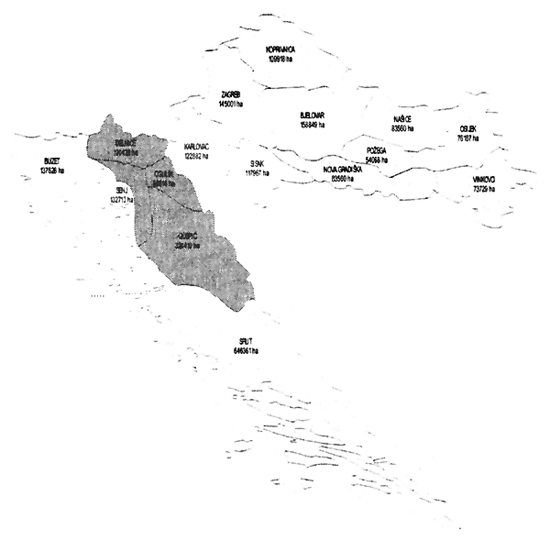
Figure 1. Area of fir-beech mountainous selection forests
Forest harvesting in mountainous selection fir-beech stands is determined by the following characteristics:
Felling and processing is completely carried out by the use of chainsaws. For processing fir, the hauling length method is used, characterized by the length of assortments (4 to 12 m) and adapted to the means of secondary transportation of wood, while beech is processed by the cut-to-length method.
Wood bunching and extracting is performed by skidders equipped with one-drum or double-drum winches (LKT 80, LKT 81, Silva, Timberjack 240 C). They are used for skidding 95 percent of all processed assortments (Sabo, 2000). In addition to skidders, adapted agricultural tractors are also used for wood extraction, while mobile yarders are only used from time to time. The reasons for the present sporadic use of mobile yarders in Croatia lie primarily in their high purchase price and higher operating costs compared with skidders, as well as in their requirement for highly organized and trained teams of operators.
Secondary (further) transport of roundwood is mostly carried out by trucks, as railway transport is not so common. For the transport of roundwood, different types of trucks are used with trailers or semi-trailers. Each truck is equipped with a hydraulic crane, installed behind the cabin or at the end of the extended chassis of the truck, depending on the type of vehicle.
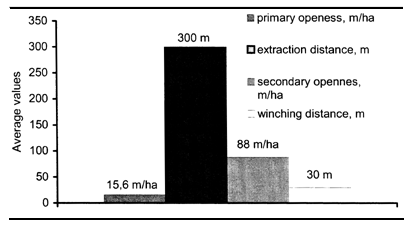
Figure 2. Average openness and distances of wood skidding and bunching.
Because of the combined use of skidders and trucks for primary and secondary transportation of roundwood, forest harvesting has to rely on a network of forest and public roads. Forest roads are expected to reduce the distance and costs of wood extraction; strip roads and skid trails to reduce winching and mobility of loaded vehicles on mountainous terrain of higher or lower slope. Figure 2 shows the average values of primary and secondary openness, i.e. distances of extracting and bunching wood for the Delnice Forest Administration, a typical selection forest.
Strip roads and skid trails in fir-beech selection stands represent the basic network of secondary forest openness, which provides the quickest and shortest way to felled and processed trees. Forest opening through a system of strip roads and skid trails rationalizes the felling site work, providing cost efficient felling, processing and wood extraction. Strip roads and skid trails are constructed on forest terrain with the slope gradient ranging between 30 and 60 percent with the terrain stone content, because of karst conditions, reaching up to 90 percent. With fine stands opening through a network of skid roads, the optimum openness ranges between 100 and 200 m per hectare. In the system of secondary stand openness with higher density of skid roads, their spatial distribution on the forest area is determined by terrain configuration.
In this paper, some research results of skidding wood by the Timberjack 240C cable skidder in the stand opened through a built network of road strips are compared with research results of yarding wood by the Steyr KSK 16 mobile tower yarder in the stand without secondary openness.
Methods and places of investigation
The performance of the skidder and mobile tower yarder was investigated by the use of a work and time study. The operating time of both means of extraction was split into operating elements with some constants determined in advance in accordance with the set goal of research. Time consumption of operating elements was recorded by the use of the snap-back timing method along with recording the working day.
The distances of unloaded and loaded travel were measured by the use of tape, and the slope gradient of the terrain and of strip roads was measured by clinometer. The load data were collected by measuring the diameter and length of each piece of roundwood. The data obtained were processed by mathematical statistical methods with the use of personal computers. After having processed and analysed the data, the results of the research were synthesized and are presented further on in the text.
Skidding wood by cable skidder Timberjack 240C
The investigation of skidding fir long roundwood by the Timberjack 240C cable skidder with double-drum winch was carried out in mountainous conditions of fir-beech selection forests in the area of Delnice Forest Office, Delnice Forest Administration (Sub-compartment -31b, Delnice Management Unit). The growing stock of the compartment was 501 m3 per hectare, of which fir made up 84 percent, and the rest was beech. The mean breast height diameter (bhd) of fir and beech trees was 35 cm. The harvesting density was 71 m3 per hectare, or 39 trees per hectare. The volume of the mean cubic tree was 1.79 m3, and the distance between felled trees was 16 m.
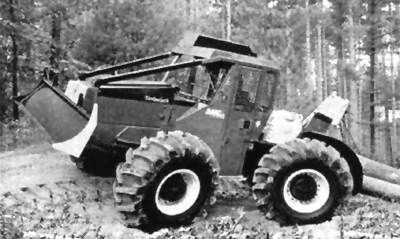
Photo 1. Timberjack 240C
The slope of the felling site ranged between 22 and 55 percent. The terrain is rich with karst phenomena (karst valleys), and most common surface obstacles are stones and stumps. Sub-compartment openness provided through a network of strip roads is 96.4 m per hectare. In felling site operations, the skidder only used strip roads with longitudinal slope, in the driving direction, ranging between -34 and +32 percent. During the investigation, the soil had a good bearing strength. The tractor driver was helped in his work by a hooker, who pulled out the winch cable and fastened the logs by use of chokers. The same hooker unfastened the load at the landing. Skidded wood assortments were bunched along the road.
Yarding wood by mobile truck yarder Steyr KSK 16
The investigation of yarding beech wood by the Steyr KSK 16 cable yarder was conducted in the area of Drežnica Forest Office, Ogulin Forest Administration, in a strictly beech even-aged stand (Compartment 23 of Bitoraj Management Unit). The growing stock of the Compartment was 369 m3 per hectare and the average bhd of trees was 32 cm. Because the slope gradient of the stand ranges between 50 and 90 percent, felling was carried out with the intensity of 59 m3 per hectare, i.e. 21 trees per hectare. The volume of the average mean cubic tree was 2.80 m3 and the distance between felled trees was 22 m.
The driving unit is installed and anchored on the forest road widening constructed above the felling site. The compartment area is covered with two stands from which eight lines are distributed in a fan-shaped arrangement.
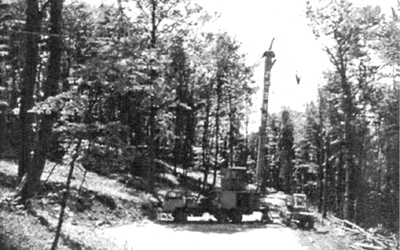
Photo 2. Truck Yarder Steyr KSK 16
Felling of trees is performed by the use of chainsaw, and then branches thinner than 10 cm are delimbed. Thus the reduced treetop is separated from the stem and the stem is cross-cut in two or three pieces depending on its diameter. In this way the balance is achieved between the mass of pieces of larger trees and the capacity of the cable yarder.
After finishing the unloaded travel, the carriage of the yarder stops above the loading site, the pulling rope is lowered and it is fetched by the worker who drags it to the load. The load is attached with chokers. When the load is attached it is skidded vertically or at an angle towards the yarder route and then it is partly or completely raised and yarded along the bearing rope to the unloading platform.
The load is lowered and released on the unloading platform and the rope is then raised and the new cycle begins. After yarding wood from the unloading platform, additional processing is carried out in the landing and commercial wood is separated from fuelwood. Four workers operate the yarder. Two of them prepare and fasten the load in the felling site, the third one unfastens the load on the unloading platform and the fourth one operates the machine. They communicate among themselves and coordinate their work by portable radio receivers.
Results of the investigation
The survey of average operating characteristics of investigated means of work is concisely shown in Table 1.
The travelling speed of the loaded yarder carriage is 5.29 km per hectare and is lower by 45.4 percent than the travelling speed of the unloaded carriage, 10.62 km per hour (see Figure 3).
The average speed of an unloaded skidder is the function of travelling of the vehicle on off-road slopes, or of its travelling on constructed strip roads of different slope gradients. Apart from the above-mentioned factors, the speed of loaded skidders is also affected by load volume.
The average travelling speed of an unloaded Timberjack 240 C on strip roads of longitudinal slope ranging between -34 percent and +32 percent in driving direction was 5.29 k per hour. The travelling speed of the loaded vehicle is lower by 24.8 percent, 3.98 km per hour (see Figure 3).
For the LKT 81 skidder under similar conditions, Krpan et al. (1999) established the travelling speed of 4.04 km per hour and 3.48 km per hour for unloaded and loaded vehicles, respectively.
The operating time consumption of the Timberjack 240C skidder at the felling site and landing (fix times) was 9.46 min per cycle and the time consumption of KSK 16 yarder for these groups of operations was lower by 38.5 percent, 5.82 min per cycle (see Figure 4).
The average load volume of the Timberjack 240C of 4.2 m3 per cycle was the effect of longitudinal slope of constructed strip roads under research work conditions, and the load volume of the KSK 16 yarder, 2.1 m3, was affected by its limited capacity (see Figure 6).
For the Timberjack 240C skidder the allowance time of 20.5 percent of the effective time was established, and for the Steyr KSK 16 yarder the allowance time is 24 percent.
Table 1. Some investigation results
| Yarder KSK 16 | Cable skidder Timberjack 240C | |
| Terrain slope | ||
| 80% (50–90%) | 45% (22–55%) | |
| Some results of extraction investigations | ||
| Unloaded travel speed, km/h | 10.62 | 5.29 |
| Loaded travel speed, km/hour | 5.80 | 3.98 |
| Felling site work, min/cycle | 4.58 ± 2.35 | 5.95 ± 2.31 |
| Landing work, min/cycle | 1.24 ± 0.52 | 3.51 ± 1.34 |
| Coefficient of allowance | 1.240 | 1.205 |
| Load volume, m3/cycle | 1.9 ± 0.8 | 4.2 ± 1.7 |
| Pieces per load | 3.4 ± 1.7 | 5.3 ± 1.7 |
| Mean volume per piece, | ||
| m3/pcs | 0.58 ± 0.59 | 0.79 ± 0.71 |
| Piece mean diameter, cm | 28 ± 14 | 34 ± 15 |
| Length of piece, m | 8.1 ± 2.9 | 7.0 ± 1.9 |
| Standard time, daily efficiency and cost of extraction for 300 m distance | ||
| Effective time, min/cycle | 10.62 | 17.38 |
| Total cycle time, min/cycle | 13.17 | 20.95 |
| Extraction efficiency, m3/hour | 9.6 | 12.0 |
| Standard time, min/m3 | 6,.27 | 4.99 |
| Cost per unit, DM/m3 | 12.90 | 5.07 |
Figure 5 shows the structure of modelled total cycle time consumption of compared means of work for the extraction distance of 300 m. A Timberjack 240C at the extraction distance of 300 m realizes a total cycle time consumption of 20.95 min. For the same extraction distance, the cycle time consumption of the KSK 16 yarder (13.17 min per cycle) is lower by 37.1 percent compared with the skidder studied.
When comparing the efficiency of the means of work at the extraction distance of 300 m, the Timberjack 240C skidder achieves the standard time of 4.99 min per m3, and the standard time for the KSK 16 yarder is 6.27 min per m3.
The dependence of efficiency on yarding wood by the KSK 16 yarder and on skidding wood by the Timberjack 240C skidder is shown in Figure 7. For both means of work, the same lowering trend of efficiency can be observed with the increase of extraction distance. Because of this characteristic, the efficiency of the KSK 16 yarder was lower by 20.6 percent than that of the Timberjack 240C skidder, notwithstanding the extraction distance.
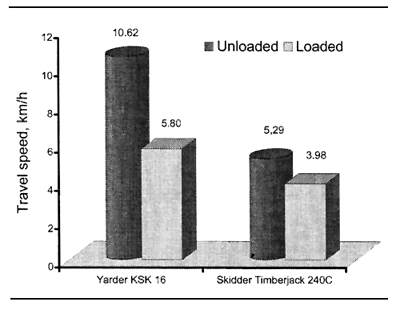 | 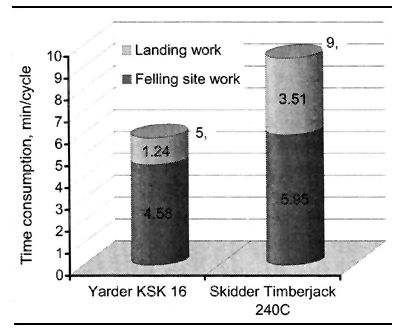 |
| Figure 3. Travel speeds | Figure 4. Fix time consumption |
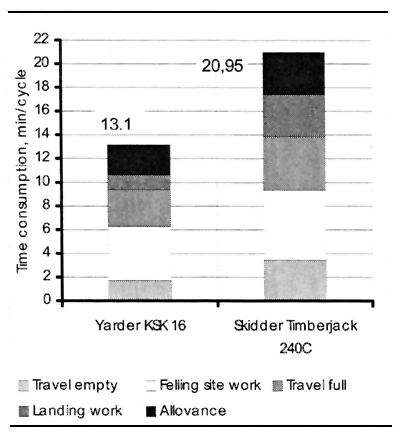 | 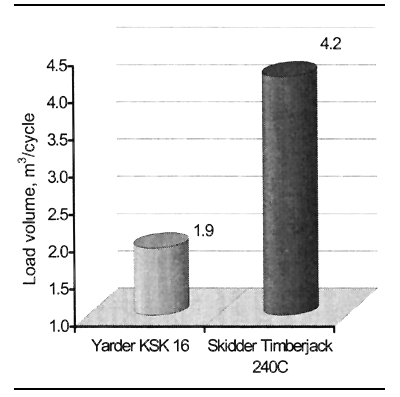 |
| Figure 5. Cycle time (extraction distance 300 m) | Figure 6. Load volume |
The planning calculation of direct costs developed by the public enterprise “Hrvatske šume” was applied for establishing the extraction costs of the means of work being investigated. According to the mentioned calculation, the costs of work of the Timberjack 240C skidder operated by an additional worker (hooker) amount to DEM 60.3 per hour, and the costs of work of the KSK 16 yarder operated by four workers amount to DEM 123.8 per hour.
Wood extraction costs were calculated (see Figure 8) based on the data of work efficiency (see Figure 7) and planning calculations for skidders and yarders. The difference in the efficiency of the means of work being investigated affected the costs of wood extraction, thus confirming the general awareness of higher costs of work performed by yarders in relation to skidders. The efficiency of yarders, lower by 20.6 percent than that of skidders, and double operating costs for work performed by yarders, makes the work unit cost of skidders lower by 61 percent than that of yarders.
It should be noted, however, that the costs of timber skidding by Timberjack 240C refer to direct extraction costs (see Figure 8), not including the costs of stand recovery after completing the works and the costs of strip roads construction. According to past experience (Grammel, 1988) aggregate costs of extraction carried out by use of skidders and yarders are more or less the same.
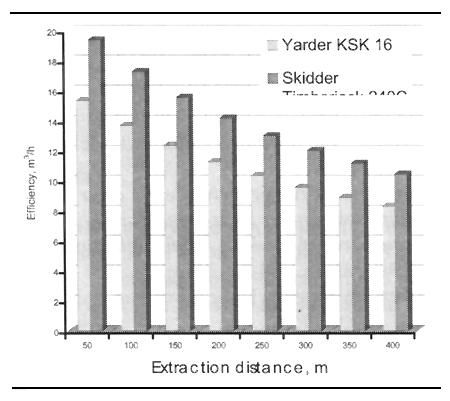 | 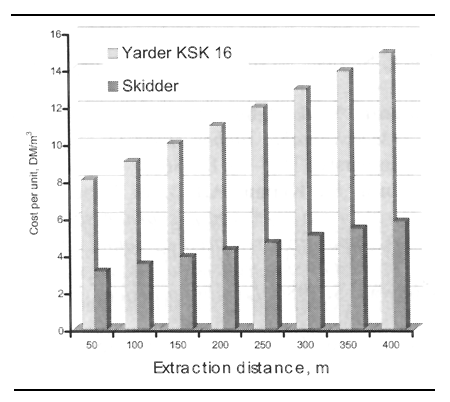 |
| Figure 7. Dependence of efficiency on extraction distance | Figure 8. Dependence of the unit cost on extraction distance |
Furthermore, the construction of secondary forest roads should not be considered as a one-time cost at the moment of harvesting the felling unit. It should rather be considered as the medium-term investment in view of the selection management of these forests and the felling cycle of 10 years.
Conclusions
This paper presents the results of an investigation of the performance of the Timberjack 240C skidder and the Steyr KSK 16 mobile tower yarder in the Croatian mountainous forests. Comparison has been made between the performance of skidders on a felling site opened through strip roads (96.4.m per hectare density) and yarders on a felling site without secondary openness. The following harvesting characteristics have been investigated: load volume, average travel speeds, felling site and landing time consumption, and allowance time.
In skidding fir roundwood, the Timberjack 240C skidder achieves the load volume of 4.2 m3 per cycle and with the Steyr KSK 16 yarder, the load volume (beech) is lower by 54.8 percent (1.9 m3 per cycle). The travel speed of an unloaded skidder is 5.29 km per hour and with the Steyr KSK 16 yarder the travel speed of an unloaded carriage is 10.62 km per hour. The loaded travel speed of the skidder is 3.98 km per hour, and the loaded yarder carriage reaches the travel speed of 5.8 km per hour. The Steyr KSK 16 yarder requires half consumption time for the felling site and landing work (5.82 min per cycle) than the skidder. Time consumption for this group of work elements performed by skidders is 9.46 min per cycle. For the Timberjack 240C skidder the allowance time of 20.5 percent of the effective time has been determined, and for the Steyr KSK 16 yarder it is 24 percent.
The analysis of work efficiency of the investigated means of work shows that the efficiency of the Steyr KSK 16 mobile tower yarder is lower by 20.6 percent compared with the Timberjack 240C skidder, and the extraction unit cost is higher by 156 percent. In spite of the higher unit costs of wood extraction, yarders as the means for wood yarding have their future in Croatia, particularly in stands where owing to terrain slope or other characteristics, the use of any other means of work is excluded. Wood yarding represents an environmentally viable technology of wood extraction, as it avoids soil treading and compaction and causes no damage to other trees in the stand.
References
Berg, S. 1992. Terrain classification system for forestry work. Forest Operations Institute “Skogsarbeten”, 1–28.
Bojanin, S. & Beber, J. 1990. Ovisnost učinka o terenskim uvjetima kod privlačenja drva traktorom (Merchantable timber skidding output with tractors depending on terrain conditions.) Mehanizacija šumarstva 15(5–6): 83–86.
Bojanin, S., Krpan, A.P.B. & Beber, J. 1988. Komparativno istraživanje privlačenja drva zglobnim traktorima u jelovim prebornim sastojinama sa sekundarnim otvaranjem i bez sekundarnog otvaranja (Comparative research of round timber skidding, by frame steered skidder, in fir selection forests, opened by skid trails, and without skid trails). Mehanizacija šumarstva 13(1–2): 3–13.
Conway, S. 1986. Logging practices, principles of timber harvesting systems. Miller Freeman Publications, 1–432.
FAO. 1996. Forest engineering and technology in private forest enterprises, by A. Trzesniowski. In Proceedings of the FAO/Austria Seminar on the Economics and Management of Forest Operations for Countries in Transition to Market Economies, 27 June-3 July 1994, Ort/Gmunden, Austria. FAO, Rome.
FAO. 1998a. Interaction between network of services: forestry and wood harvesting systems, by S. Baldini and C. Pollini. In Proceedings of the Seminar on Environmentally Sound Forest Roads and Wood Transport, 17–22 June 1996, Sinnaia, Romania. FAO. Rome.
FAO. 1998b. Recent developments on environmentally friendly forest road construction and wood transport in mountainous forests, by R. Heinrich. In Proceedings of the Seminar on Environmentally Sound Forest Roads and Wood Transport, 17–22 June 1996, Sinnaia, Romania. FAO Rome.
FAO. 1998c. Wood transport in steep terrain, by A. Trzesniowski. In Proceedings of the Seminar on Environmentally Sound Forest Roads and Wood Transport, 17–22 June 1996, Sinnaia, Romania. FAO, Rome.
Grammel, R. 1988. Holzernte und Holztransport. Verlag Paul Parey, Hamburg - Berlin, 1–242.
Krpan, A.P.B. 1997. Poredba djelotvornosti žičare STEYR KSK 16 na brdskom terenu i ravnici (Vergleich der Wirksamkeit des Seilkrans STEYR KSK 16 am Steilhang und in der Ebene). Mehanizacija šumarstva 22(2): 83–93.
Krpan, A.P.B., Poršinsky, T. & Sabo, A. 1999. Wood extraction using choker skidders LKT 80 and 81 in selection forests in mountain conditions. Abstracts Emerging harvesting issues in technology transition at the end of century, IUFRO Division 3, RGs: 3 April 2000 Operational planning and control; work study, 3.06.00 Forest operations under mountainous conditions, 30 July 2000. Ergonomics, Opatija 27 September – 1 October 1999. Faculty of Forestry of Zagreb University, 121–122.
Mellgren, P.G. 1980. Terrain classification for Canadian forestry. Canadian Pulp and Paper Association, 1–13.
Poršinsky, T., Krpan, A.P.B., Šušnjar, M. & Zečić, ž. 1999. Skidding technologies in Croatian mountainous selection forests - situation today and possibilities of future development. Abstracts Emerging harvesting issues in technology transition at the end of century. IUFRO Division 3, RGs: 3.4.00 Operational planning and control; work study, 3.06.00 Forest operations under mountainous conditions, 3.7.00 Ergonomics, Opatija 27. 9-1. 10. 1999. Faculty of Forestry of Zagreb University, 119–120.
Sabo, A. 2000. Privlačenje obloga drva zglobnim traktorom LKT 81 u gorskokotarskim prebornim sastojinama različitog stupnja otvorenosti (Timber skidding by skidder LKT 81 from selection stands with different degrees of forest opening in Gorski Kotar). Magistarski rad, Šumarski fakultet Sveučilišta u Zagrebu, 1–142.
Staff, K.A.G. & Wiksten, N.A. 1984. Tree harvesting techniques. Martinus Nijhoff/DR W. Junk Publishers, Dodrechts/Boston/Lancaster, pp. 371.
Schlaghamersky, A. 1993. Feinerschliessung. Fachhochschule Hildesheim/Holzminden, Fachbereich Forstwirtschaft in Göttingen, 1–146.
Wasterlund, I. 1996. Environgentle forestry operations - possible or must. Proceedings of the Seminar Progress in Forest Operations, 8 May 1996. Ljubljana, Slovenia, 9–14.